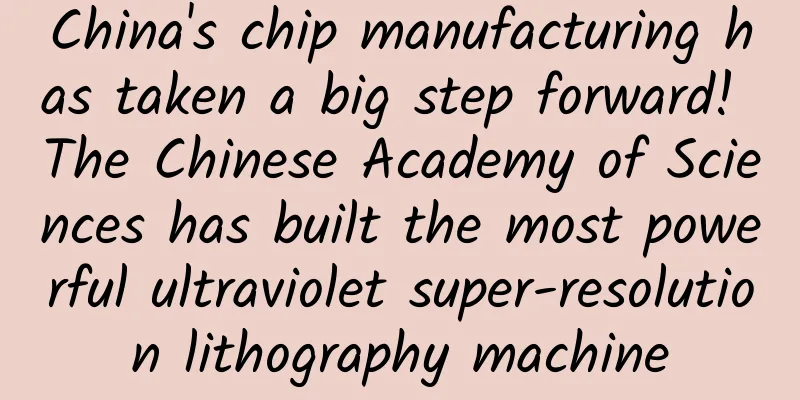China's chip manufacturing has taken a big step forward! The Chinese Academy of Sciences has built the most powerful ultraviolet super-resolution lithography machine

|
my country has made new breakthroughs in chip manufacturing! After nearly seven years of hard work, the "Super-resolution Lithography Equipment Development" project passed the acceptance test. This means that China now has "the world's first ultraviolet (i.e. 22nm@365nm) super-resolution lithography equipment with the highest resolution". In other words, Chinese scientists have successfully developed a very powerful lithography machine. Lithography machines are the core equipment for chip manufacturing. my country has always been controlled by others in the chip industry, especially in the field of lithography machines, which are often restricted by foreign countries such as strangulation and sales ban. Regarding this breakthrough, the acceptance expert group's opinion is: The maximum line width resolution of this lithography machine in a single exposure is 22 nanometers at a wavelength of 365 nanometers. The project has broken through the diffraction limit of resolution in principle, established a new research and development route for high-resolution, large-area nanolithography equipment, and bypassed relevant foreign intellectual property barriers.
When the news came out, many people praised it, but most of them were confused and felt it was impressive. Of course, some people said it was just bragging. What does this news really mean? There are many highlights in this breakthrough, among which there are several points that deserve attention. Quantum Bit briefly summarizes them as follows: Light source: thick knife engraving fine lines This domestically produced lithography machine uses a 365-nanometer wavelength light source, which is in the near-ultraviolet range. Usually, in order to pursue smaller nano-processes, the solution of lithography machine manufacturers is to use light sources with shorter and shorter wavelengths. ASML has this idea. The light source of the most widely used lithography machine abroad is 193 nanometer wavelength deep ultraviolet laser , and the lithography resolution is only 38 nanometers, about 0.27 times the exposure wavelength. This domestically produced lithography machine can achieve 22 nanometers. Moreover, "combined with double exposure technology, it can also be used to manufacture 10-nanometer chips in the future." In other words, the lithography machine developed by the Institute of Optoelectronics of the Chinese Academy of Sciences uses a light source with a longer wavelength (near ultraviolet) and lower cost (mercury lamp) to achieve higher lithography resolution (0.06 times the exposure wavelength). Hu Song, deputy chief designer of the project and researcher at the Institute of Opto-Electronics Technology of the Chinese Academy of Sciences, made an analogy in an interview with China Science Daily: "This is equivalent to using a very thick knife to carve out a very thin line." This is what is called breaking through the diffraction limit of resolution . Therefore, it is also known as the world's first ultraviolet super-resolution lithography equipment with the highest resolution.
Cost: High-end equipment at bargain prices The shorter the wavelength, the higher the cost. In order to obtain higher resolution, the traditional approach to improve lithography machines is to shorten the light wave, increase the numerical aperture of the imaging system, and so on. However, the problem is that not only is the technology extremely difficult, but the equipment cost is also extremely high . ASML's latest fifth-generation lithography machine uses a shorter wavelength of 13.5 nanometer extreme ultraviolet (EUV) to achieve 14 nanometer, 10 nanometer, and 7 nanometer process chip production. Such a lithography machine costs more than $100 million. The equipment from the Institute of Optoelectronics of the Chinese Academy of Sciences uses ultraviolet light with a longer wavelength and is more common, which means that domestic lithography machines use low-cost light sources to achieve higher-resolution lithography. Some netizens commented that the lithography machines made in China might become very cheap in the future, just like other high-tech equipment mastered by China.
Breakthrough: Breaking the embargo and overtaking others The emergence of this lithography machine has another important significance. Here we quote the report from China National Radio: The smooth implementation of the super-resolution lithography equipment project has broken the monopoly of foreign countries in the field of high-end lithography equipment, provided a new solution for nano-optical processing, and provided core technical guarantees for advanced strategic technology fields such as new generation information technology, new materials, biomedicine, basic frontiers and national defense security. Hu Song, deputy chief designer of the project and researcher at the Institute of Optoelectronics Technology of the Chinese Academy of Sciences, said: "The first is that our current level is consistent with the international level. The resolution index is actually an index that is embargoed by foreign countries. Our project will be of great help in breaking the embargo ." "Secondly, we don't have to worry if there is a foreign embargo, because we believe that our technology can be guaranteed if we continue to develop. In the future development of chips, the next generation of optomechanical integrated chips, or what we call broad chips (in the research and development field), we may overtake others and get ahead."
Limitations Of course, we can't get carried away. The emergence of this equipment does not mean that my country's chip manufacturing will immediately advance by leaps and bounds. On the one hand, chip manufacturing is a huge industrial ecosystem, and on the other hand, the lithography machine of the Institute of Optoelectronics of the Chinese Academy of Sciences still has certain limitations. It is reported that this equipment has currently produced a series of nano-functional devices, including large-aperture thin-film mirrors, superconducting nanowire single-photon detectors, Cherenkov radiation devices, biochemical sensor chips, metasurface imaging devices, etc., verifying the equipment's nano-functional device processing capabilities and reaching a practical level.
In other words, currently they are mainly devices in the fields of optics and so on. However, some Zhihu netizens said that "with current technical capabilities, we can only make periodic lines and dots, and it is impossible to produce the graphics required for complex ICs." This technology is said to be "unable to be applied to the field of IC manufacturing in the short term, and cannot shake ASML's position in the field of IC manufacturing in the slightest...but it has posed a certain threat, and it is still possible to achieve more important breakthroughs in the long term." The backward status of China's lithography machine manufacturing At present, the main manufacturers of lithography machines in the world are ASML of the Netherlands, Nikon of Japan, and Canon. Among them, ASML has the most advanced technology. There are also companies in China that produce lithography machines, such as Shanghai Micro Electronics Equipment, but their technological level is far behind ASML. The lithography machines currently produced by Shanghai Microelectronics Equipment can only process 90-nanometer process chips, which is already the highest level of domestic lithography machines. ASML has already mass-produced 7-nanometer process EUV lithography machines, and there is at least a decade of technological gap. Lithography is the core equipment for chip manufacturing, and it has always been China's technological weakness in the past. The level of lithography has seriously restricted the development of China's chip technology. We have been "stuck in the neck". Domestic chip manufacturers such as SMIC and Yangtze Memory Technologies had to buy lithography machines from ASML at high prices.
In May this year, Nikkei Asian Review reported that SMIC placed an order for a US$120 million EUV lithography machine from ASML, a major international semiconductor equipment manufacturer, which is expected to be delivered in early 2019. In addition, Yangtze Memory also purchased an immersion lithography machine from ASML this year for US$72 million. So, what exactly is the so-called lithography machine? Lithography machine principle Photolithography is one of the core equipment for chip manufacturing. Hu Song and He Xiaodong from the Institute of Optoelectronics of the Chinese Academy of Sciences introduced its importance in an article published in the Voice of the Chinese Academy of Sciences: The post-industrial era, including the current Industry 3.0 and Industry 4.0, are all based on chips. As a tool for manufacturing chips, the lithography machine is equivalent to the machine tools in the industrial era and the manpower in the pre-industrial era. But what is special is that the lithography machine uses light as a "tool". Specifically, the process flow is roughly as follows: A layer of highly light-sensitive photoresist is covered on the surface of the silicon wafer, and then light is irradiated onto the surface of the silicon wafer through a mask. The photoresist exposed to the light will react. After that, the irradiated/unirradiated photoresist is washed away with a specific solvent, thus realizing the transfer of the circuit pattern from the mask to the silicon wafer. Source: "Understanding Photolithography Machines in One Article", Huachuang Securities This is just a simplified process. Normally, if you want to use a lithography machine to make a chip, you need to perform hundreds of overlays and thousands of processes on extremely fine structures, and hundreds of types of equipment are needed to complete it. The lithography machine successfully developed by the Chinese Academy of Sciences has a capacity of 22 nanometers. What does this mean? The article by the Chinese Academy of Sciences mentioned a comparison: The diameter of a hair is about 80 microns, and 22 nanometers is 1/3600 of the diameter of a hair. In other words, this lithography machine can process various complex structures on the surface of hair. Who developed this lithography machine? 7 years of exploration by the Institute of Optoelectronics, Chinese Academy of Sciences
The research institution behind this lithography machine is the Institute of Optoelectronics of the Chinese Academy of Sciences. The person who took the lead in completing this research and development task is Researcher Luo Xiangang , Director of the Institute of Optoelectronics of the Chinese Academy of Sciences, chief scientist of the super-resolution lithography equipment project, professor and doctoral supervisor at the University of Chinese Academy of Sciences.
Luo Xiangang's academic status in the field of optoelectronics can be seen from his long list of titles: He is the director of the National Key Laboratory of Microfabrication Optical Technology, the chief scientist of the National 973 Program, the winner of the 2016 National Technological Invention First Prize, a valid candidate for the 2017 election of academicians of the Chinese Academy of Engineering, a recipient of the National Outstanding Young Scientist Fund, one of the first batch of scientific and technological leaders of the Organization Department of the CPC Central Committee's Ten Thousand Talents Program, a national candidate of the 2009 "New Century Hundred Thousand Talents Program", a candidate of the 2004 Chinese Academy of Sciences "Hundred Talents Program", and a Fellow of the four major societies: the Chinese Optical Society, the Optical Society of America, the International Society for Optical Engineering, and the International Society for Optoelectronics and Laser Engineering. Luo Xiangang has been engaged in the optoelectronics field for more than 20 years since he started studying for his master's degree at the Institute of Opto-Electronics Technology, Chinese Academy of Sciences in 1995. After completing his master's and postdoctoral studies at the Institute of Opto-Electronics Technology, Chinese Academy of Sciences, he went to the RIKEN Institute of Physical and Chemical Research in Japan as a postdoctoral fellow and research scientist. In 2004, Luo Xiangang returned to the Institute of Optoelectronics Technology of the Chinese Academy of Sciences where he studied and began to work as a researcher. In his more than 20 years of optoelectronics research, he has not only published more than 100 SCI papers, but also trained dozens of outstanding master and doctoral students.
Hu Song, deputy chief engineer of the project, is also a researcher at the Institute of Optoelectronics Technology of the Chinese Academy of Sciences and a doctoral supervisor at the University of Chinese Academy of Sciences. He has extensive experience in optical projection exposure micro-nano processing technology and micro-processing lithography technology. He enjoys a government subsidy from the State Council and has presided over many national, ministerial and provincial scientific research projects and published more than ten patented technologies. It took the Institute of Optoelectronics of the Chinese Academy of Sciences 7 years to complete this project. According to the Economic Daily, in 2012, the Institute of Optoelectronics of the Chinese Academy of Sciences undertook the task of developing super-resolution lithography equipment, a major national scientific research equipment project. At that time, there was no mature foreign experience to draw on. Over the past seven years, the project team has made breakthroughs in key technologies such as high-uniform illumination, super-resolution lithography lenses, nanometer-level resolution focus and gap measurement, and ultra-precision, multi-degree-of-freedom worktable and control, and completed the development of the world's first ultraviolet super-resolution lithography equipment with the highest resolution. It uses a 365-nanometer wavelength light source and has a maximum line width resolution of 22 nanometers for a single exposure (about 1/17 of the exposure wavelength). On this basis, the project team also combined the supporting processes such as high aspect ratio etching and multiple patterning developed by the super-resolution lithography equipment project to achieve the processing of graphics with feature sizes below 10 nanometers. In addition, this project has published 68 papers, applied for 92 national invention patents, of which 47 were authorized, applied for 8 international patents, of which 4 were authorized, and trained a super-resolution lithography technology and equipment R&D team for the country. |
<<: Analyst: iPhone will need a big price cut or redesign next year
Recommend
Has Pinduoduo reached a growth turning point?
For a long period of time, the e-commerce industr...
B Station Brand Marketing Guide!
Among the many New Year’s Eve parties in 2019, Bi...
Mercedes-Benz new E-class starts at RMB 422,800
The 2016 Guangzhou Auto Show has kicked off. Merc...
This museum actually "moved" a real tropical rain forest here!
The Cosmobox Science Museum in Barcelona opened t...
How to make birthday greetings for African children?
Videos of African children holding up signs to se...
Apple products to watch in 2024: iPhone 16, Apple Intelligence, and other expected "Glowtime" releases
Apple will launch the iPhone 16 at its "It&#...
Listen to stories and learn Swift series - Xiao Ming and the red envelope (optionals - optional type)
[[143647]] The naughty child Xiao Ming and his mo...
Badou College AI Practical Tutorial-Courses Specialized for Employment 2021
Badou College AI Practical Tutorial-Courses Speci...
What should you do if you have spring allergies and tears?
Since March, the number of patients suffering fro...
World Economic Forum: Global hydrogen energy competition intensifies, EU increases policy support for renewable hydrogen
China, the United States and Japan have all intro...
Learn these 7 tips to draw perfect icons
Hello everyone, I am Brian. Icons are the most ba...
How to protect user privacy information? See how big companies handle it!
Let’s summarize the practices and design points o...
Emotional experts teach you how to become a good chatterbox, learn how to date, and master the secrets of getting along with girls [audio course]
Have you ever noticed a problem, a scumbag has no...
AI plays games better than humans? But what's the point of letting AI play games...
Welcome to Science Popularization China’s special...
After years of hard study, don’t go to a fake university!
Mixed Knowledge Specially designed to cure confus...









